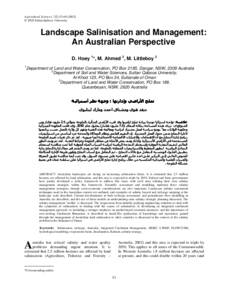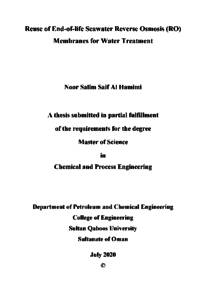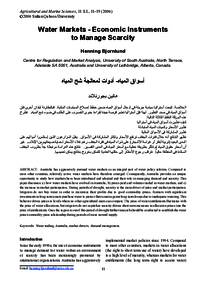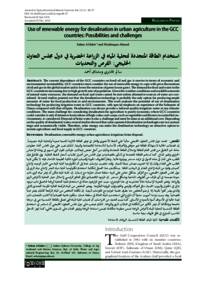Document
Landscape salinisation and management an Australian perspective.
Contributors
Ahmed, M., Author
Littleboy, M., Author
Publisher
Sultan Qaboos university
Gregorian
2002
Language
English
Subject
English abstract
Australian landscapes are facing an increasing salinisation threat. It is estimated that 2.5 million hectares are affected by land salinisation, and this area is expected to triple by 2050. Federal and State governments have jointly developed a policy framework to address this issue, with each state refining their own salinity management strategies within this framework. Scientific assessment and modelling underpin these salinity management strategies, though socio-economic considerations are also important. Landscape salinity assessment techniques used in the Australian context are outlined, and examples of salinity hazard and recharge mapping at the landscape scale described. Current developments in both recharge assessment, and groundwater flow modelling in Australia are described, and the use of these models in underpinning state salinity strategic planning discussed. The salinity management 'toolkit' is discussed. The progression from initially applying engineering solutions to deal with the symptoms of salinisation; to dealing with the causes of salinisation; to developing an integrated catchment management approach; to including a stronger emphasis on market-based economic measures; and the importance of over-arching Catchment Blueprints, is described in detail. The application of knowledge and experience gained through the management of Australian land salinisation to other countries is discussed in the context of the salinity problem in the Sultanate of Oman.
Member of
ISSN
2410-1079
Resource URL
Citation
Hoey, D., Ahmed, M., & Littleboy, M. (2002). Landscape salinisation and management: an Australian perspective. Journal of Agricultural and Marian Sciences, 7 (2), 53-60.
Arabic abstract
تواجه أستراليا تهديدا بزيادة تملح أراضيها وقد قدرت الأراضي المتأثرة بالملوحة بحوالي 2.5 مليون هكتار ومن المتوقع أن تزداد هذه المساحة بثلاثة أضعاف (7.5 مليون هكتار) بحلول عام 2050. وقد قامت الحكومة الفيدرالية وحكومة الولايات معا بوضع سياسة لعمل مشترك لدراسة ومعالجة هذه القضية وتقوم كل ولاية بالعمل حسب برنامجها لإدارة التملح ضمن جدول العمل المشترك. إن التقييم العلمي ونظام المحاكاة والنمذجة جزء أساسي من استراتيجيات برامج إدارة التملح مع أن الاهتمامات والاعتبارات الاقتصادية الاجتماعية أيضا ضرورية. لقد تم ذكر تقنيات تقييم الملوحة المستخدمة في الأراضي الأسترالية وكذلك وصف بعض الأمثلة عن مخاطر الملوحة وخرائط التغذية. لقد تم وصف التطور الحالي لتقيم التغذية الجوفية واستخدام النمذجة الرياضية لدراسة انسياب المياه الجوفية كما تمت مناقشة استخدام النماذج الرياضية لتطوير التخطيط والاستراتيجيات المتعلقة بالملوحة. كما تم وصف التقدم في مجال إدارة التملح بداية بتطبيق الحلول الهندسية للتعامل مع دلالات التملح، ثم التعامل مع أسباب التملح وتطوير طريقة الإدارة المتكاملة للحوض المائي إلى التركيز على أخذ تدابير اقتصادية على مستوى السوق. وقد تمت أيضا مناقشة تطبيق المعرفة والخبرات العلمية والميدانية المكتسبة من خلال برنامج إدارة تملح الأراضي في أستراليا على سلطنة عمان في محيط مشكلة الملوحة.
Category
Journal articles




